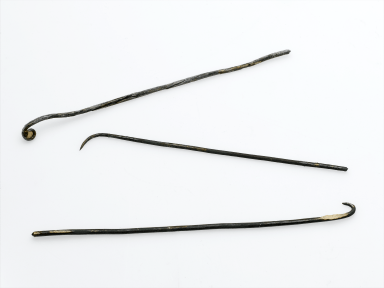Neuroscience in Ancient Egypt
By ucbtch1, on 21 February 2018
You might think that ancient Egypt has nothing to do with neuroscience but you would be wrong. When ancient Egyptians practiced mummification, the brain was usually liquefied and pulled out from the cranium through the nose using a hook-like tool—a method known as excerebration. You do this by making a hole in the back of the neck and withdraw it through the foramen, which is the opening at the bottom of the skull where the spinal cord exits the cranium. [1]
Interestingly, the Greek writer Herodotus described this process of removing the brain in the 5th century BC. He writes, “ Since the brain was not perceived as important as the heart, it was deemed useless for the afterlife, and so it was disposed of. But in some cases, the brain was not removed and it was simply left in the skull. [2]

Copies of hooks or cranial crochets used to remove the brain from the skull. (Image: Science Museum, London, A634908 Pt1).
Even though the brain was not considered of high importance, it was the Egyptians who first described the cerebral cortex. The first ever written description of the human brain was found in the Edwin Smith Surgical Papyrus written around 1700 BC, which is a copy of a much older text dating around the 30th century BC.[4]
This papyrus describes various cases of patients and their illnesses. In one of the cases, a patient had a hole in the head and the brain was left exposed. The author writes how he saw “corrugations” like the ones in molten copper. These “corrugations” are the first known written description of the cerebral cortex, which has grooves and gives the brain its characteristically wrinkly appearance. Notably, the author also writes about the cerebrospinal fluid, aphasia—an injury related to impairment of language—and he even describes seizures as “he shudders exceedingly”. [4]
Although the author may not have been fully aware of the importance of the brain, this papyrus is meaningful because of its rational descriptions at a time when most medical writings were filled with mysticism and magic. At the same time, it represents the beginnings of the amazing journey to discover the workings of the human brain, which has now flourished into modern-day neuroscience.
References:
- Fanous, A.A. and W.T. Couldwell, Transnasal excerebration surgery in ancient Egypt: Historical vignette. Journal of neurosurgery, 2012. 116(4): p. 743-748.
- Lamb, D.S., Mummification, Especially of the Brain. American Anthropologist, 1901. 3(2): p. 294-307.
- Godley, A.D., Herodotus, the histories. 1920, Cambridge: Harvard University Press.
- Gross, C.G., From imhotep to hubel and wiesel, in Extrastriate Cortex in Primates. 1997, Springer. p. 1-58.
 Close
Close


